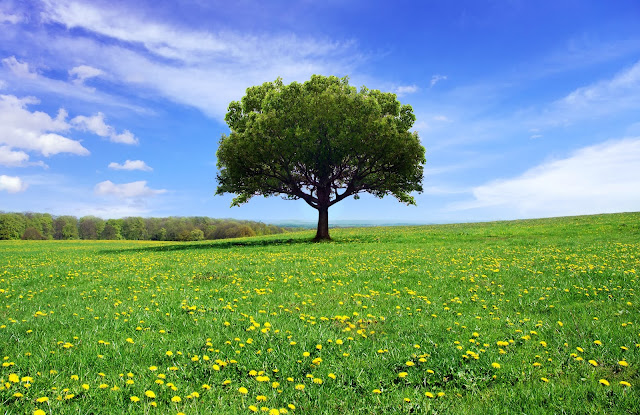The picture above, imagined by most of us, yet not realized in the environments we place or allow plants and shrubs to take home, is one of the examples I use most when speaking with property owners - a tree growing in an open meadow.
The specimen above is receiving full sunlight throughout the day - growth, nutrients and photosynthesis not impeded by other trees or plant life. This girl has all she needs and is probably the subject of many drawings in kindergartens and early school years - how many of us have perceived trees, plants, this way?
Even so, only from this picture, slightly seeing the branch structure and foliage, without looking into the tree, I can say this is truly one healthy and beautiful specimen.
Wouldn't we all love to have such a feature tree (or a few), perhaps smaller, on our property? Well, whether it be a shrub or tree, we aren't so fortunate and they all need attention, because the environment isn't nearly the same.
I love and have trimmed/sheared and shaped many shrubs, observing the growth habit, never committing to some totally round or rectangular shape - the most incredibly boring orbs or blocks lacking in healthful consideration of the given shrub. Similar techniques in caring for trees apply to shrubs, just on a different scale.
Yet, to the topic of this post, many plants will be subject to trimming, shearing and shaping throughout the growing season. Which is wonderful, but most of this needs to be accented with some sound pruning techniques as heavy shearing or trimming leads to a dense outer-shell, resulting in dead or dying interior stems (the dead zone) and health issues which result from lack of air circulation and competition from cross branches and others fighting for sunlight - azaleas being one of the culprits and victims of such misfortune.
One can't go willy nilly, making cuts (pruning) on shrubs on trees or shrubs without knowing some of the morphology, physiology or growth habit of said plants, and not knowing how to properly prune, without consideration of health and future growth.
Pruning is part art and part science, but can't be art without the science, leading to proper care and future of the plant.
You may be able to train (which is almost always accomplished by pruning at a young age) a plant to behave the way it may have grown naturally, or the way you prefer. Yet, some health and aesthetic concerns can be addressed with a mature tree or shrub.
We all know the value of a well-cared-for-lawn, mowing, edging, etc., but, beautiful, well-shaped and attended-to healthy plants on one's property enhance the property's appeal and its value, greatly.
Plants are ever-evolving, adaptive and have the good fortune of not having the thought process us humans possess (which muddles most everything). For what they achieve in propagation and proliferation, they are no-less wise, perhaps wiser.
Plants, substantial plants, such as shrubs and trees, need our care or else they will become our bane, rather than all they are capable of being.



No comments:
Post a Comment